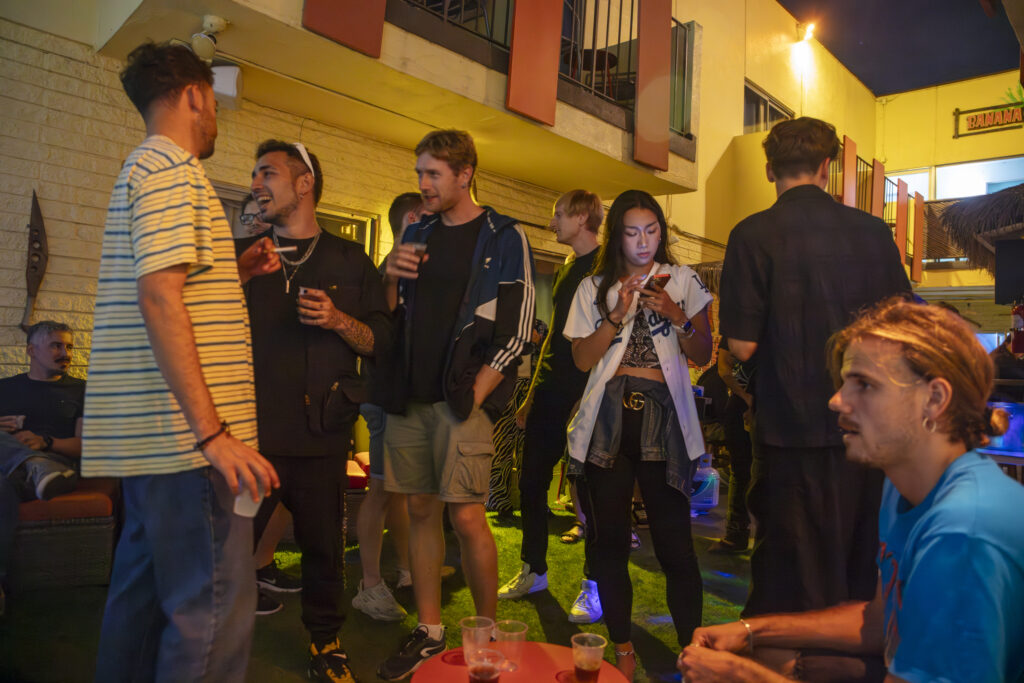
It’s a sunny afternoon on Hollywood Boulevard, not far from the eastern end of the Walk of Fame, and Trey Triplett is conversing with a new friend from Greece on the patio of the Banana Bungalow.
What looks like a sapphire, two-story motel with a metal gate entrance is a hostel, one of 235 in the United States, according to Hostelworld. Opened in 1992, the Bungalow features 20 private rooms and 11 dormitories, including two exclusive female dorms.
The parking lot also serves as a courtyard with a basketball hoop and a side area with sofa surrounding a wall-mounted television. Both the Hollywood Sign and the Netflix building are visible day and night. Going downstairs at the back of the hostel, there is a small recreation garden and patio with a straw-decked tiki bar and furniture where guests can mingle.
A Chicago native and military veteran, Triplett initially came to Los Angeles to be close to his daughter, who loves the beach. He now frequents hostels in the city to meet new people, which he does in the courtyard and patio.
He said his first exposure to the hostel lifestyle happened when he served overseas in England.
“You get to meet interesting people from all walks of life,” Triplett said. “You have artists, musicians, creatives and techie people, but there’s a great mix of international flair. It’s a true bonding experience you can’t get in a regular hotel where everyone just goes around each other.”
The international guests at the Banana Bungalow hail from several countries, including France, Germany, India, Japan, Korea and Austria.
Hostels are a variety of lodging for tourists and travelers designed with shared accommodations, such as dormitories with bunk beds and shared bathrooms, not unlike on-campus housing in colleges. Though popular throughout Europe, hostels can also be found in Central America, Australia and Asia, and some Americans might be surprised to find them around their country.
According to Duncan Simpson, a hostel and travel expert in England, the first youth hostel was built in 1909 in Germany for weary walkers and travelers who covered long distances by foot. These establishments started to spread across international borders in 1924, and they didn’t reach the United States until 1934 in Massachusetts.

As technology began to expand in the subsequent decades, Simpson said the market exploded with growing demand from backpackers.
“It happened because of all the changes in the international travel of budget airlines,” Simpson said. “And then, of course, there was the internet at the end of the 20th century. The ‘80s saw a rise in private hostel ownership out to make a profit besides the ones run by official organizations running them as a charity or voluntary organization.”
While youth hostels are typically geared for younger demographics, although most are open to all ages. Some hostels bar underage guests.
There have been some negative preconceptions surrounding hostel life, given the notoriety of the horror franchise “Hostel.”
But Triplett said such a reputation doesn’t dissuade travelers if they keep common sense and follow safety guidelines.
“I like my organs where they are, but Halloween is around the corner,” Triplett joked. “So if that’s going to happen, I’ll stay at a hotel.”

The Banana Bungalow prioritizes safety for its guests, especially its international demographic. The owners dissuade them from sharing their entrance keypad passwords with outsiders. It is considered wise to stay in a room with a friend or family member.
Urban hostels such as the Banana Bungalow offer guests a variety of activities designed to take advantage of the tourist attractions the city has to offer. Rural hostels often offer walking, canoeing, whitewater rafting, or cycling opportunities, depending on where they are.
When guests call it a day at the Bungalow, they are served free dinner and BBQ, provided and cooked by the staff. It is a good time for visitors to mingle and socialize, perhaps playing foosball, billiards or singing karaoke.
New employee Devin Lauder enjoys making strong personal connections, which makes hostel life more attractive compared to staying at a hotel. He works at the front desk in the small office between the entrance and parking area.
Lauder said it’s a neat experience to catch up with familiar faces from previous guests and learn from new ones.
“I like meeting people from all over the place, especially the ones from Europe who are more accustomed to being in hostels,” Lauder said. “People like to hang out in the common area and share things with each other in a nice communal atmosphere.”



